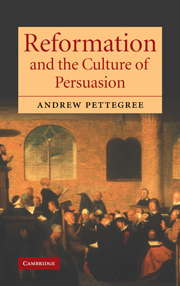3 - Militant in song
Published online by Cambridge University Press: 04 December 2009
Summary
A Catholic visitor to a Protestant worship service in sixteenth-century Europe would immediately have been struck by stark contrasts to the familiar tradition of his own upbringing. The scale of the physical alterations would obviously vary, depending on whether he had stumbled upon a church cleansed of all images for Calvinist worship, or a Lutheran church, in which the internal fabric might be largely untouched. But it is unlikely, one might surmise, that if the service were in progress, his mind would linger much on architecture and internal decoration: more arresting by far was the essential unfamiliarity of the worship service. For a start, there would only have been one service in progress; in this Protestant church he would not have observed one priest celebrating Mass at the High Altar, while others were engaged in duties in the side chapels. No priests would have been hearing confession; the familiar bustle and variety would have been missing. Rather the attention of the congregation gathered in the nave would have been focused on the pulpit, from which the minister would be conducting the service. If his arrival was unplanned, our Catholic visitor would in all likelihood have first heard the voice of the minister, leading the congregation in prayer, reading from Scripture or preaching. Preaching would obviously have occupied the longest time: probably an inordinate length for someone not inured by long practice.
- Type
- Chapter
- Information
- Reformation and the Culture of Persuasion , pp. 40 - 75Publisher: Cambridge University PressPrint publication year: 2005
- 1
- Cited by

